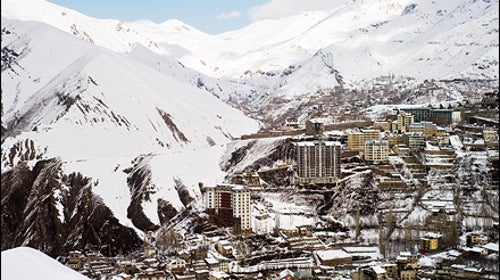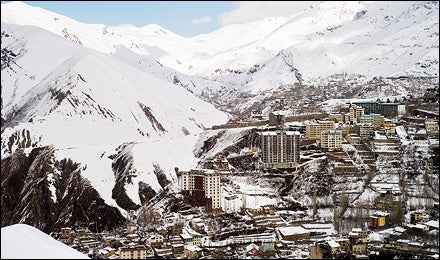Skiing Iran
 Farshad Kahlili and the author boot toward untracked snow at Shemshak
Farshad Kahlili and the author boot toward untracked snow at ShemshakSkiing Iran
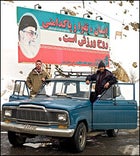 The powder patrol at the base of Dizin
The powder patrol at the base of DizinSkiing Iran
 Skiers at Shemshak
Skiers at ShemshakSkiing Iran
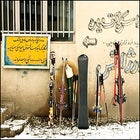 Idle gear at the resort's base
Idle gear at the resort's baseSkiing Iran
 A memorial billboard on the road up
A memorial billboard on the road upSkiing Iran
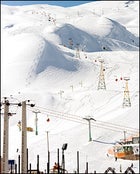 A sunny day at Dizin
A sunny day at DizinVALI ASR AVENUE, IN CENTRAL TEHRAN, is a bustling hub of sports retail. There are soccer shops and bike shops, shops that sell wrestling apparel and those that offer only hats, including a few auto-racing caps with beer logos which is funny, because it’s been illegal to consume alcohol in Iran since 1979. You’ll also find shops full of skis and snowboards imported from Europe. Look closely and you’ll even spot some American gear.
╠ř
The ski equipment makes sense once you gaze north, straight uphill, as Vali Asr broadens and climbs 2,000 feet toward the base of a white-topped mountain that looms above Tehran’s deservedly notorious smog: 13,005-foot Mount Tochal.
If you squint at the lower regions of this steeply pitched peak, you’ll see a gondola stop, the start of a seven-station ferry that takes skiers to the top of one of the world’s highest ski areas located here, within the municipal boundary of the capital of the Islamic Republic of Iran, archnemesis of the United States, circa now.
Tochal is just one mountain in a towering, 560-mile-long range known as the Alborz, which divides northern Iran’s vast salt desert from the lush hillsides fronting the Caspian Sea. I’ve come during the wet spring of 2007 to snowboard several resorts in the range, starting at Tochal. Three days after arriving in Tehran, I make the trip up for the first time.
The gondola’s base sits amid a cluster of rickety amusement rides and tea shops. Few people are kicking around the dusty, snowless courtyard, but one young Iranian snowboarder spies my Burton board and waves. He’s wearing big sunglasses and has his helmet clipped to a pair of cargo pants. He would blend in seamlessly at Big Bear.
“Bur-ton,” he calls out, in heavily accented English. “Where you are from?”
“America.”
“A-mer-i-ca?!” he replies, his tone somewhere between a question and a shriek. “We are your enemy, no?”
I’m not sure how to answer that. Technically, yes our governments hate each other. Personally, no I’m here as a curious tourist in search of friendly faces.
He shares the news with a lift operator, whose eyes bulge. “NBA?” he says, doing a quick mental scan of his English dictionary. “Ma-gic John-son! Sha-keel Oh-neal!” There’s a pause. “Mi-kel Jor-dan!” He erupts in laughter.
I cram into a six-seat Poma cabin with my guide, Farshad Kahlili, having just passed under a sign that reads, in English, TRUST US AND ENJOY THE NATURE. It’s a peculiar message, but apt. At various times during the nearly 45-minute ascent to 12,073 feet, the 29-year-old cabin dangles 100 feet over boulders and craggy rocks. It looks like the upper regions of Squaw or Snowbird gnarly, steep, fun.
Unfortunately, Farshad informs me, most of these areas are off-limits for much of the winter because the snow is poor. What’s open is way up top, in a large, shallow bowl served by a pair of lifts.
When we disembark, snow is blowing sideways. All the inbounds terrain is intermediate and, this being Friday (the Muslim sabbath), the place is abuzz with affluent, stylishly attired Iranian teenagers who are, for the most part, very bad at skiing and snowboarding. Women in Iran aren’t supposed to show their hair in public, but they do up here. I see a few scarves, and at one point I think I see two women skiing in full chadors, but otherwise the women show little concern for containing their locks.
Later, on one of the chairs, I talk to a teenager named Ali, a 16-year-old from Tehran who says he’s been snowboarding “one year only.” I am “maybe the tenth” American he’s ever met, he adds, just as the lift sputters to a stop, a not uncommon occurrence. Unlike the boarder down below who, like nearly everyone I’ll meet in Iran, was both befuddled and thrilled by the sudden appearance of an American Ali seems unsurprised. He’s mostly interested in how high I can jump.
And then, as kids around the world are wont to do, Ali starts bouncing in the chair. Violently. Above and behind us, young people cheer and screech. Soon, chairs are moving like plastic bobbers on a stormy lake. One girl, her streaked hair completely uncovered, keeps blowing a whistle, as if a snowy rave is about to ensue. No one is fazed.
It doesn’t take long to exhaust the terrain. That afternoon, on my final descent of the day, I run into a woman I met earlier, Foutuhe Shahrad, a friend of Farshad’s who scoots around on pastel, eighties-era skis. She’s taking a breather by a lift tower.
“You like the skiing?” she asks sweetly.
Very much, I reply. “Maybe you will go back to America and tell everyone how nice it is in Iran,” she says. “Tell them please not to start a war with us.”
IT WAS A WEIRD TIME for a ski trip, to say the least.
By the start of 2007, tensions between the U.S. and Iran had reached levels not seen since the 1979 toppling of the shah and the subsequent hostage crisis. In December, the United States arrested several Iranian citizens under suspicion of aiding in attacks on Iraqi security forces. Then, not long before I left on my trip, U.S. officials presented evidence that Iran had been funneling arms to Shiite militants in Iraq. Iran, of course, was outraged, especially after Iraq’s president said they were in the country at his request.
Meanwhile, Iran continued to defy United Nations orders that it halt the enrichment of uranium, claiming that the country’s intentions at its nuclear facilitiesÔÇöwhich the Bush administration might well destroy as a parting giftÔÇöare only to pursue the peaceful development of cheap power. Guided since June 2005 by President Mahmoud AhmadinejadÔÇöa rabble-rouser known for bon mots like “Anybody who recognizes Israel will burn in the fire of the Islamic nation’s fury”ÔÇöIran has been especially aggressive since the U.S. took out the Taliban and Saddam Hussein, cementing the nation’s status as the region’s dominant Islamic power.
But I couldn’t resist visiting. For years, I’d heard whispers about Iran’s impressive mountains and abundant snow. What finally snagged me was the anomaly of it allÔÇöthe idea that a U.S.-style snow-sports culture exists in a country that officially bans hand holding by unmarried couples. Was the skiing-and-boarding scene just a ghost of the shah’s Westward-leaning reign? Or was Iran’s massive young population testing new boundaries of liberalization?
I wouldn’t have gotten anywhere near the place if not for Farshad, who secured my visa and made all the arrangementsÔÇöa process that took months. He’s a cofounder of Iranian Mountain Guides, a startup that appears to be the country’s first backcountry-skiing-and-mountaineering outfit. He picked me up at the airport in his old, faded-blue Jeep Wagoneer.
“Let me tell you about some laws,” Farshad said as we drove away from Mehrabad Airport. “You must not talk to women or take photographs. You must not photograph soldiers. You must not speak politics on the street.” He paused. “I don’t like this way of things, but this is how it is.”
Farshad is a short, sinewy man of 43. He’s been skiing for seven years and climbing in the Alborz since he was a kid. One of his favorite places is Damavand, a dormant volcano that, at 18,605 feet, is the tallest peak in Iran. He’s climbed it some 60 times and skied it more than ten. If weather permits, he’ll take curious visitors just about anywhere in Iran’s vast and untouched backcountry, but I was more interested in seeing who was hanging around at the resorts.
The day after skiing Tochal, we head over to the Iran Ski Federation, a government-run sports body housed in a drab two-story building in northeast Tehran. The federation’s officials are clearly nervous about having an American journalist in their midst, and only after ferocious closed-door negotiating with Farshad do they agree to field my questions.
Farshad and I take our seats facing a pair of desks. At one sits Payan Nazar, the federation’s public relations manager. His uncle runs the ski school at Tochal. At the other is federation official Bahram Saveh Shemshaki, son of the organization’s president, Issa Saveh Shemshaki, a famous Iranian skier. Bahram’s cousin Alidad is currently the country’s top-ranked alpine specialist, which is not exactly like skiing for Austria. At the Turin Olympics, he finished 29 seconds back in the giant slalom.
Bahram is a stylish guy with wire-rim glasses and a black shirt open to his chest. He tells me that residents of the ski town of Shemshak, where he grew upÔÇöhence his last nameÔÇöhave been skiing for 75 years. Some basic use of skis for transportation has been going on in the Alborz range for hundreds of years, but the downhill sport as we know it arrived around 1930, when German miners introduced the peculiar pastime to locals. Only a tiny percentage of Iranians skiÔÇömostly people who live in mountain villages or the posh sections of TehranÔÇöand the presence of ski tourists from elsewhere is almost nil.
The federation, Bahram explains, exists to oversee Iran’s ski “zones” (resorts) and also to support national-team members in snowboard, alpine, cross-country, and grass skiing, a bizarre and dangerous summertime offshoot. This year, the federation added boardercross to the quiver and for the first time sent a halfpipe rider to an international competitionÔÇöthe Asian Games, in Changchun, ChinaÔÇödespite the fact that there’s not a single terrain park, let alone a halfpipe, in all of Iran.
“Snowboarding is new,” Bahram says. “A lot of people like to test it. But I think it will go back to alpine.”
If that sounds familiarÔÇölike the grumbling you’d hear from skiing purists at Taos or Mad River GlenÔÇöyou’re about right. For the older generation, Iranian snow sports froze stylistically in 1979, when the takeover by Islamic fundamentalists all but outlawed fun. What was left to hang on, barely, was a Euro-inspired skiing infrastructure put in place by the last shah of Iran, Mohammad Reza Shah Pahlavi, a passionate skier who encouraged development of the major resorts.
Little has been added since: Only one of the big resorts has built so much as a new lift in the intervening decades. It’s hard to say how close skiing came to going extinct, but government policy, then as now, was one of grumpy toleration for a frivolous Western activity. Popular rumor has it that ski resorts were shuttered after the rise of the mullahs, but that’s mostly myth. Tochal was shut down for 20 years, but the two biggest areas, Dizin and Shemshak, stayed open.
They did so only by a series of miracles, and thanks to the dedication and bravery of people who worked there. Veterans of that scene still tell wild stories about the period following the revolution, when religious zealots stormed the gates, shook the support towers, and literally stoned gondolas while a few bold (or crazy) skiers ascended.
ABOUT 45 MINUTES OUT OF TEHRAN, on a two-lane road that cuts into the mountains along a river of dishwater-colored rapids, big, wet flakes start to fall. Soon everything past the guardrails is whited out as we climb toward Kandovan Pass, which crosses the Alborz range from north to south, topping out at more than 8,000 feet.
Farshad is giddy; it rarely snows like this so late in the year. I ask if he prefers winter or summer, a fair question for a skiing mountaineer. “That is difficult,” he answers. “It’s like, Do you prefer your mother or your father?”
╠ř
We pass a turnoff for the Khor Ski Area, a tiny place with “only one small lifter,” Farshad says. Technically, there are more than a dozen ski zones in Iran, but all except five are like Khor: dinky. The ones that matter are, in descending order of size, Dizin, Shemshak, Darbandsar, Tochal, and Ab Ali. All of them lie in the Alborz, none more than a two-and-a-half-hour drive from the luxury apartment towers of north Tehran.
Though Shemshak, which opened in 1958, is very popular, Dizin became the heart of the country’s ski industry after it launched in 1969. It offers the most acreage, the biggest vertical drop (3,117 feet), and one of the longest seasons, opening in late November and sometimes closing as late as June 1.
@#95;box photo=image_2 alt=image_2_alt@#95;box
One reason for Dizin’s surge was that it captured the attention of important people. General Fatollah Minbashian, jefe of the shah’s ground forces, built a large home across the road from the lifts. The low-slung mansion is often mistakenly referred to as the shah’s “winter palace,” but belonged to Minbashian and served as the big man’s crash pad for ski trips. Minbashian took up skiing with great fervor. He forced his security detail to take lessons until they were good enough to ski in formation behind him. He even wrote a ski manual.
The clouds break. Massive peaks rise before us, slathered in white. I’m pretty sure I hear Farshad say “yum.”
“I think it is perfect for us!” he says.
Pulling into Rudbarak, the last village before Dizin, we stop beside a large sign depicting the grimacing face of the deceased father of Islamic Iran, Ayatollah Ruhollah Khomeini. He’s at the head of a wedge of notable martyrs from the Iran-Iraq War, the 1980 1988 conflict that left an estimated one million Iranians and Iraqis killed. The air is still and clear, and here, for the first time, we hear the call to prayer, a mournful song echoing in the valley.
In the morning we hit the slopes. An old gondola car hangs from a decrepit stone arch, marking the entrance to Dizin, a massive three-sided bowl that, at 8:30 A.M., is nearly devoid of activity. The ski area is a vast panorama of white, rising dramatically and stretching so far from one end to the other that you could probably plop a couple of American resorts in the valley and still have room for expansion. We park near a car full of Iranian kids listening to Farsi hip-hop while chugging Red Bull and lacing up their snowboard boots.
After picking up my $9 lift ticket, I run into Farid Lotfi, a bearded 30-year-old with iron- cross earrings and the leathery skin of a resort regular. He pops out his iPod earbuds and informs me that he’s the freestyle and boardercross champion of Iran and that his sponsors include Rip Curl and Palmer. He considers his boast a moment, then qualifies it. “The village boys are strong,” he allows. “After them, I am the best.”
When he’s not training, Farid cobbles together cash by instructing. Today, he has two young students to deal with. He says we should give him a call later and perhaps “make a party.”
In the U.S., our vision of Iran is of a barren and intolerant desert populated by teetotaling zealots. In reality, the country has a diverse and well-educated population of 70 million and is in the midst of a Western-flavored youth boom. The open secret around these parts is that Iran’s more prosperous young people do not lack for entertainment. One day on the slopes, a young tech entrepreneur tells me that a black market services Tehran apartments, delivering beer, wine, and hard liquor as well as drugs like cocaine, ecstasy, and speed. These delivery services operate at a high level of risk the penalty for dealing drugs can include execution, sometimes by public hanging.
Twice during my trip, I smoke pot with locals, but never in front of Farshad, who wouldn’t allow it. The first time is in a Tehran apartment, where a friend of a friend grows his own. The second is on the lift at Dizin, with two Tehran businessmen in their thirties, enjoying a powder day on the mountain. If you have money here, they tell me, anything is possible.
THE APPROACH TO DIZIN’S gondola station is broken into three separate lines designated by Farsi signs. I assume these are for separating ski-patrollers from ticket holders, but the real purpose is to make sure men and women don’t share cars. When we head to the shortest line, we’re stopped by a surly lift op.
“This one is for ladies,” Farshad explains. Even so, there’s socializing the girls chatter away with the boys through metal bars that divide the lines, giggling and flipping their hair.
@#95;box photo=image_2 alt=image_2_alt@#95;box
The 20-minute wait for the creaky, ancient cable car is worth it once we’re atop the eastern ridge at Dizin. We clip in and drop over the lip of a wide groomer that draws all the traffic just a few feet off the trail, the powder is knee-deep and untracked. From one end of Dizin to the other there’s virgin snow. We stop at the midstation and hop a second Poma to the top, where Farshad leads us on a long traverse to the east around a bend in the mountain. You can drop off at any point and find your own powder field. The snow is as good as anything I’ve experienced in Utah or British Columbia soft and fluffy, none of it shallower than my boots. On a snowboard, it’s like heaven.
In a long and snaking gondola line, I meet yet another Ali, a teenager from Tehran who is also intrigued by my board. He’s dressed in head-to-toe Burton, with a Shaun White jacket that’s been available only since last winter. This indicates he’s traveled, which he has to Italy last year. He loved the discos.
╠ř
“American girls!” he says. “Nice!” We run out of words that we both understand and exchange an awkward high-five. “You call me in Tehran,” he says, scrawling a number in my notebook. “I will show you some parties! Maybe some beautiful girls!”
The sun is high in the sky, and it feels like Tahoe: Dudes recline on their snowboards, posturing for girls wearing enough makeup to go clubbing. (Though there are no legal clubs to go to.) Looking at the terrain, it’s hard not to believe that this place, in theory, has the potential to be world-class. In the pie-eyed days of the shah, there was talk of connecting Dizin and Tochal by gondola, and today nearly everyone seems to hold out hope for improvement. None of the skiers I meet is more passionate about this than Behrouz Kalhor, an international racer from the seventies who remains one of Iran’s most famous skiers.
Even at 47, Behrouz still skis every day of the season. He tells me that, in the early seventies, an official from the International Ski Federation, the sport’s governing body, came to Dizin and took it all in. “He said,” Behrouz recalls, “that this is one of the best pistes in the world.”
TO GET TO SHEMSHAK, you begin a slow, six-mile descent from Dizin’s upper parking lot on a road that hugs the side of the mountain, hundreds of feet above the valley floor. Close to the bottom, two lifts rise on the right each one arrow-straight and pointed uphill into a bowl. This is Darbandsar, Iran’s only privately owned ski resort, which explains why it has the highest ticket price around $12 and the only high-speed quad.
Further on is Shemshak, which is lower than Dizin and oriented east instead of north. The result is a warmer valley with a shorter season and wetter snow. People who prefer skiing here tend to talk about the steeper trails indeed, it is no place for beginners and the lower percentage of snowboarders.
That night we eat kebabs for the seventh straight day. My room at the Shemshak Complex Hotel is, alas, like something from a Krakow hostel. There are strange black hairs on my blanket, a shower that only trickles, and a drain that doesn’t. But that’s all right, because we wake up the next morning to more new snow.
“I can’t believe it,” Farshad says. “Your New Year’s gift!”
For all of its flaws, the dreary hotel couldn’t be better situated. If I were to leap out my window and time it perfectly, clearing the stairs and some scrubby trees, I could almost land on one of the lift chairs. We buy tickets from three guys at a table in a shack next to the lift. They’ve only just fired up the massive engine that runs the ancient two-seater.
It’s a chilly, bluebird day. I wouldn’t quite call the conditions dust-on-crust it’s deeper than dust but the skiing is tough and icy compared with the miracle we experienced at Dizin.
“This is difficult,” I say to Farshad.
“I think horrible,” he says. “It’s a good mountain, but I think not in spring.”
Even so, it’s amazing what a little hike past the out-of-bounds sign will do. We trudge through knee-deep snow up a knife-ridge. It’s hard work, but the reward is a deep, steep field of untouched snow, not powder or porridge but something soft and silky, like fine sand.
At lunch, an Iranian woman stops me to ask where I’m from, speaking perfect English. She is Laila Amin, a glamorous middle-aged mom in a fur hat who’s eating kebabs with her two young children. She went to Yale but now lives in Tehran. She’s been skiing at Shemshak for 35 years. Dizin has too many snowboarders for her tastes, and she also finds its lift lines unruly.
Real estate here is booming, Laila says slopeside chalets go for $250,000 and up but skiing is cheap. “In Utah you pay $80 for a ticket, and I know an instructor who charges $100 an hour,” she says. “Here, for $50, you can have an instructor all day.”
“You like this hotel?” she asks. “It’s OK, but if I took it over, I’d serve drinks to foreigners, like in Dubai. If they prioritize, this would be much nicer. But right now, it’s the government, and they have very little interest.”
THE VILLAGE OF SHEMSHAK, like most any Iranian town, has as its primary place of worship an impressive building of spindly spires and onion domes known as an imamzadeh. What most foreigners, myself included, assume to be a mosque is actually a Shiite shrine containing holy relics.
I asked Farshad to bring me here out of curiosity, but like nearly every experience we’ve had in the Alborz, we’ve ended up circling back to the snow. Inside, he spots a friend, telling me in a whisper, “He is very famous in this zone.”
The man is Mostafa Mirhashemi, 32, Iran’s foremost nordic skier. He represented Iran at the 2002 Olympic Games in Salt Lake City, rounding out the country’s team of two athletes. Mostafa missed last year’s Turin Games, but Iran had a capable backup: his older brother Mojtaba, who is 41.
Nordic skiing is the rarest snow sport of all here it exists almost exclusively for the smattering of men who compete in the national-team pool. Like all of the country’s top skiers, Mostafa and Mojtaba get little support from the government. For the most part, the brothers make do with club sponsorships and side jobs. They raise bees for honey, give lessons, and rent and sell ski equipment at a small shop in town. Mostafa takes great pride in these mountains and what they offer to Iranians.
“After the revolution, it was difficult for women to ski,” he says. “Now it’s much easier. This makes me happy to see.”
An older woman in a chador comes over and chatters in Farsi. It’s Mostafa’s mother, urging her son to invite us to their home to look at photographs.
We hop into Mostafa’s red van and head down the narrow valley road to their house. A cluster of shops hugs a bend in the road, and Mostafa pulls in, parks, and leads us down a lane. To one side is a steep hill covered in snow. “When I was two, I skied here,” he says. “I carried my skis to the top.”
We enter a small foyer, remove our shoes, and walk up some steps into a warm room empty of furnishings but full of children two boys and two girls, all of them small, giggle at our presence. Every one of them, Mostafa says, is a skier.
In the corner of the room, there’s evidence of a proud mother: The fireplace mantel is decorated with trophies, medals, and race credentials. We drink tea and look at pictures, and the experience is touching and telling. Here’s a man in his thirties, living with his parents and devoting himself to a sport that, in Iran, barely exists at all. The mountain villages are full of people like this. As the ski federation’s Bahram Shemshaki told me, “In Shemshak and Dizin, before they walk, they learn to ski.”
At the same time, you’ve got a large group of hipsters from Tehran using the ski resorts as a way to experiment with freedom, to intermingle and express themselves with thick mascara, pink cargos, and techno music delivered by iPod.
The groups intersect in ski shops and caf├ęs, like the one down the hill from my Shemshak hotel. ║┌┴¤│ď╣¤═°, it’s drab. Inside, there’s the vibe of modern ski lodge, complete with Red Bull and a fridge full of a new mineral water called Aqua Viva that comes in a bottle shaped like aftershave. Its slogan? THE FOUNTAIN OF YOUTH.
